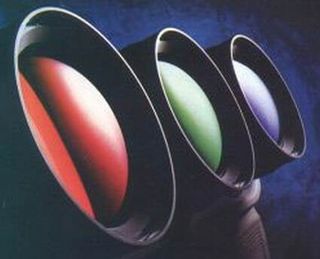Home Theater Cinema Paradiso With Video Projectors
Forget about expensive LCD TV screens: A digital video projector can do a better job for a whole lot less. A blank white wall and an investment of less than $1,500 can transform your living room into a movie theater minus the $10 plus tickets and obnoxious crowds. THG illustrates how now-affordable digital video projectors work as well as what to avoid.
CRT Technology
Tri-tube projectors reconstitute the color image through its red, green and blue components. Unlike LCD, DLP and D-ILA projectors, these three images are superimposed directly on the screen and not inside the projector. Each lens is placed in front of a monochrome (red, green or blue) cathode-ray tube. The tubes operate on the same principle as television tubes, except that they're smaller. They operate at a very high luminosity level, and heat dissipation is handled by a liquid cooling system.
The monochrome tubes have no mask and are limited only by their size and the quality of the electronics. Unlike LCD, DLP and D-ILA projectors, which have resolutions of 800x600, 1024x768, etc., tri-tube projectors can adapt to all resolutions. A grill inside the tube extracts electrons from the cathode, which is heated in the tube's vacuum. These electrons continue on their way to the phosphor layer. When they collide with it, a photon is released, producing light. The remanence of the phosphor and retinal persistence combine to produce the final image. The three red, green and blue images that are projected are superimposed exactly on the screen to result in a perfect color image.

Sign up to get the BEST of Tom's Guide direct to your inbox.
Get instant access to breaking news, the hottest reviews, great deals and helpful tips.
Current page: CRT Technology
Prev Page D-ILA Technology Next Page Advantages And Disadvantages Of CRT Technology